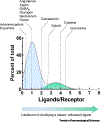Biased Allosteric Modulators: New Frontiers in GPCR Drug Discovery
- PMID: 33581873
- PMCID: PMC9797227
- DOI: 10.1016/j.tips.2020.12.005
Biased Allosteric Modulators: New Frontiers in GPCR Drug Discovery
Abstract
G protein-coupled receptors (GPCRs) are the largest class of cell surface receptors in the genome and the most successful family of targets of FDA-approved drugs. New frontiers in GPCR drug discovery remain, however, as achieving receptor subtype selectivity and controlling off- and on-target side effects are not always possible with classic agonist and antagonist ligands. These challenges may be overcome by focusing development efforts on allosteric ligands that confer signaling bias. Biased allosteric modulators (BAMs) are an emerging class of GPCR ligands that engage less well-conserved regulatory motifs outside the orthosteric pocket and exert pathway-specific effects on receptor signaling. The unique ways that BAMs texturize receptor signaling present opportunities to fine-tune physiology and develop safer, more selective therapeutics. Here, we provide a conceptual framework for understanding the pharmacology of BAMs, explore their therapeutic potential, and discuss strategies for their discovery.
Keywords: G protein-coupled receptor (GPCR); allosteric modulation; drug development; functional selectivity; signaling bias; β-arrestin.
Copyright © 2021 Elsevier Ltd. All rights reserved.
Conflict of interest statement
Declaration of Interests US patents 9 868 707 and 10 118 902 relating to the chemistry of ML314, SBI-553, and their derivatives have been issued to the Sanford Burnham Prebys Medical Research Institute and Duke University (M.G.C. and L.S.B.).
Figures




References
-
- Lagerstrom MC and Schioth HB, Structural diversity of G protein-coupled receptors and significance for drug discovery. Nat Rev Drug Discov, 2008. 7(4): p. 339–57. - PubMed
Publication types
MeSH terms
Substances
Grants and funding
LinkOut - more resources
Full Text Sources
Other Literature Sources

